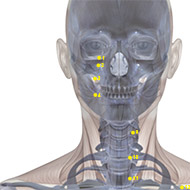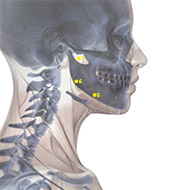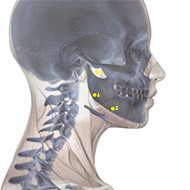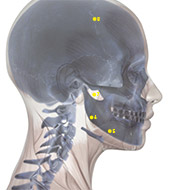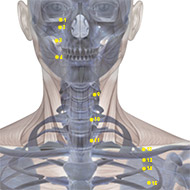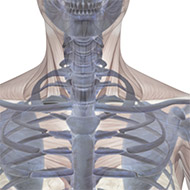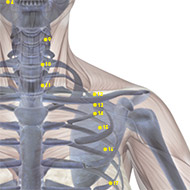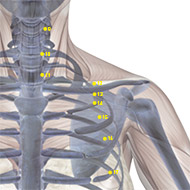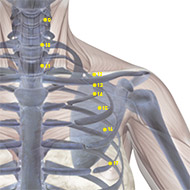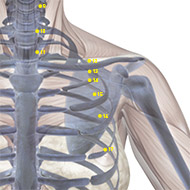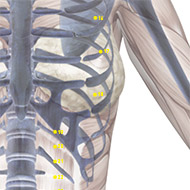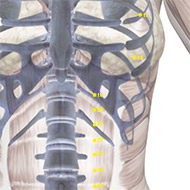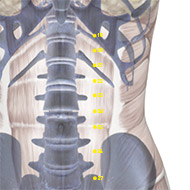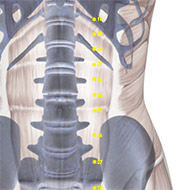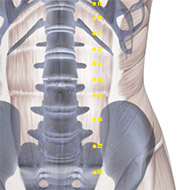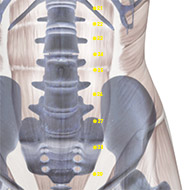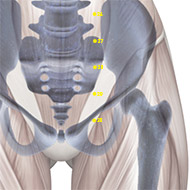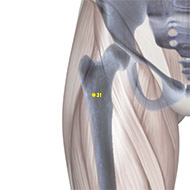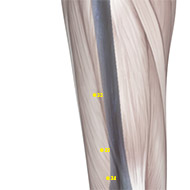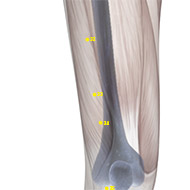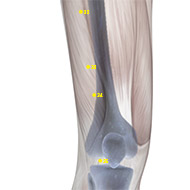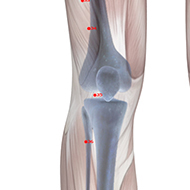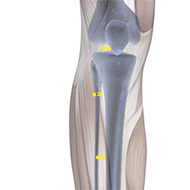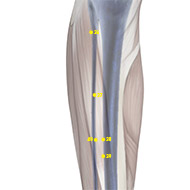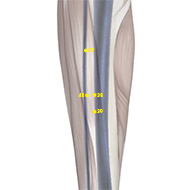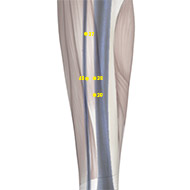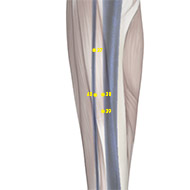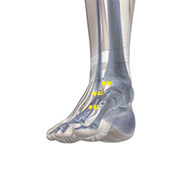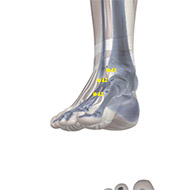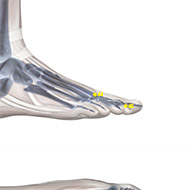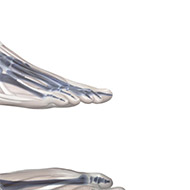Rated Acupoints
Stomach Meridian / Channel Acupuncture Points
Stomach Meridian / Channel Acupuncture Points.The meridian system (simplified Chinese: 经络; traditional Chinese: 經絡; pinyin: jīngluò, also called channel network) is a concept in Traditional Chinese medicine (TCM) about a path through which the life-energy known as “qi” flows.1 The twelve standard meridians, also called principal meridians, are divided into Yin and Yang groups. The Yin meridians of the arm are Lung, Heart, and Pericardium. The Yang meridians of the arm are Large Intestine, Small Intestine, and Triple Burner. The Yin Meridians of the leg are Spleen, Kidney, and Liver. The Yang meridians of the leg are Stomach, Bladder, and Gall Bladder.2 The Stomach Meridian or Stomach Channel is one of the 12 principal meridians in TCM. It corresponds with the Taiyin Spleen Meridian of the Foot. The Flow Hours of this meridian are 7:00 AM – 9:00 AM.3
CONTENTS
ORGAN AND FUNCTION
ACUPOINTS
FLOWING ROUTES
ORGAN AND FUNCTION
The stomach, a concept from traditional Chinese medicine as distinct from the Western medical concept of stomach, is more a way of describing a set of interrelated parts than an anatomical organ. The Stomach and its paired organ, the Spleen, are associated with the element of earth and the emotions of anxiety and stress.4 It has the following principal functions:
-It transforms the food and drink we ingest. “Rotting and ripening” is the process of fermentation which prepares the way for the Spleen to extract the refined essence from food. After the refined part of the food and fluids has been extracted by the Spleen, the Stomach passes the remainder to the Small Intestine for further separation and absorption.
-It sends the transformed food down to the Small Intestine for further separation.5
If the stomach is too dry, the stomach Qi cannot descend and food cannot be moved down to the small intestine. On the other hand, if the spleen is too damp (humid), the spleen Qi cannot ascend and fluids and food cannot be transformed. Further, the stomach easily suffers from excess, spleen easily suffers from deficiency. In addition, the stomach is prone to heat, but the spleen is prone to cold (producing humidity). In detail, the stomach tends to suffer from deficiency of Yin, whereas, the spleen tends to suffer from deficiency of Yang.6
ACUPOINTS
This meridian contains 45 acupoints in one side, that is 90 acupoints in total.
ST-1
Location: With the eyes looking straight forward, the point is directly below the pupil, between the eyeball and the infraorbital ridge.
Indications: Redness, swelling and pain of the eye, lacrimation, night blindness, twitching of eyelids, facial paralysis.
Acupuncture Method: Push the eyeball upward with the left thumb and puncture perpendicularly and slowly 0.5-1.0 inch along the infraorbital ridge. It is not advisable to manipulate the needle with large amplitude.
Vasculature: The branches of the infraorbital and ophthalmic arteries and veins.
Innervation: The branch of the infraorbital nerve, the inferior branch of the oculomotor nerve and the muscular branch of the facial nerve.
ST-2
Location: Directly below the pupil, in the depression at the infraorbital foramen.
Indications: Redness, pain and itching of the eye, facial paralysis, twitching of eye lids, pain in the face.
Acupuncture Method: Puncture perpendicularly 0.2-0.3 inch. It is not advisable to puncture deeply.
Vasculature: The branches of facial artery and vein, the infraorbital artery and vein.
Innervation: The branches of the facial nerve. The point is right on the course of the infraorbital nerve.
ST-3
Location: Directly below the pupil, at the level of the lower border of ala nasi, on the lateral side of the nasolabial groove.
Indications: Facial paralysis, twitching of eyelids, epistaxis, toothache, swelling of lips and cheek.
Acupuncture Method: Puncture perpendicularly 0.3-0.5 inch. Moxibustion is applicable.
Vasculature: The branches of the facial and infraorbital arteries and veins.
Innervation: The branches of the facial and infraorbital nerves.
ST-4
Location: Lateral to the corner of the mouth, directly below the pupil.
Indications: Deviation of the mouth, salivation, twitching of eyelids.
Method: Puncture subcutaneously 1.0-1.5 inches with the tip of the needle directed towards Jiache (ST-6). Moxibustion is applicable.
Vasculature: The facial artery and vein.
Innervation: Superficially, the branches of the facial and infraorbital nerves; deeper, the terminal branch of the buccal nerve.
ST-5
Location: Anterior to the angle of mandible, on the anterior border of the attached portion of m. masseter where the pulsation of facial artery is palpable, in the groove-like depression appearing when the cheek is bulged.
Indications: Facial paralysis, trismus, swelling of the cheek, pain in the face, toothache.
Acupuncture Method: Avoid puncturing the artery. Puncture obliquely 0.3-0.5 inch. Moxibustion is applicable.
Vasculature: Anteriorly, the facial artery and vein.
Innervation: The facial and buccal nerves.
ST-6
Location: One finger-breadth (middle finger) anterior and superior to the lower angle of the mandible where m. masseter is prominence when the teeth are clenched and depressive when it is pressed.
Indications: Facial paralysis, toothache, swelling of the cheek and face, mumps, trismus.
Method: Puncture perpendicularly 0.3-0.5 inch or subcutaneously with the tip of the needle directed towards Dicang (ST-4). Moxibustion is applicable.
Vasculature: The masseteric artery.
Innervation: The great auricular nerve, facial nerve and masseteric nerve.
ST-7
Location: On the face, anterior to the ear, in the depression between the zygomatic arch and the mandibular notch. This point is located with the mouth closed.
Indications: Deafness, tinnitus, otorrhea, toothache, facial paralysis, pain of the face, motor impairment of the jaw.
Acupuncture Method: Puncture perpendicularly 0.1- 0.5 cun. Moxibustion is applicable.
Vasculature: Superficially, the transverse facial artery and vein; in the deepest layer, the maxillary artery and vein.
Innervation: The zygomatic branch of the facial nerve and the branches of the auriculotemporal nerve.
ST-8
Location: On the lateral side of the head, 0.5 cun above the anterior hairline at the corner of the forehead, and 4.5 cun lateral to the midline of the head.
Indications: Headache, blurring of vision, ophthalmalgia, lacrimation.
Acupuncture Method: Puncture 0.5-1.0 inch subcutaneously.
Vasculature: The frontal branches of the superficial temporal artery and vein.
Innervation: The branch of the auriculotemporal nerve and the temporal branch of the facial nerve.
ST-9
Location: Level with the tip of Adam’s apple where the pulsation of common carotid artery is palpable, on the anterior border of m. sternocleidomastoideus.
Indications: Sore throat, asthma, goiter, dizziness, flushing of the face.
Acupuncture Method: Avoid puncturing the common carotid artery, puncture perpendicularly 0.3-0.5 inch.
Vasculature: The superior thyroid artery on the bifurcation of the internal and the external carotid artery.
Innervation: Superficially, the cutaneous cervical nerve, the cervical branch of the facial nerve; deeper, the sympathetic trunk; laterally, the descending branch of the hypoglossal nerve and the vagus nerve.
ST-10
Location: At the midpoint of the line joining Renying (ST-9) and Qishe (ST-11), on the anterior border of m. sternocleidomastoideus.
Indications: Sore throat, asthma, coughs.
Acupuncture Method: Puncture perpendicularly 0.3-0.5 inch. Moxibustion is applicable.
Vasculature: The common carotid artery.
Innervation: Superficially, the cutaneous cervical nerve; deeper, the superior cardiac nerve issued from the sympathetic nerve and the sympathetic trunk.
ST-11
Location: At the superior border of the sternal extremity of the clavicle, between the sternal head and clavicular head of m. sternocleidomastoideus.
Indications: Sore throat, pain and rigidity of the neck, asthma, hiccup, goiter.
Acupuncture Method: Puncture perpendicularly 0.3-0.5 inch. Moxibustion is applicable.
Vasculature: Superficially, the anterior jugular vein; deeper, the common carotid artery.
Innervation: The medial supraclavicular nerve and the muscular branch of ansa hypoglossi.
ST-12
Location: In the midpoint of the supraclavicular fossa, 4 cun lateral to the anterior midline.
Indications: Cough, asthma, sore throat, pain in the supraclavicular fossa.
Acupuncture Method: Avoid puncturing the artery. Puncture perpendicularly 0.3-0.5 inch.
Deep puncture is not advisable. Moxibustion is applicable.
Vasculature: Superiorly, the transverse cervical artery.
Innervation: Superficially, the intermediate supraclavicular nerve; deeper, the supraclavicular portion of brachial plexus.
ST-13
Location: At the lower border of the middle of the clavicle, 4 cun lateral to the anterior midline.
Indications: Fullness in the chest, asthma, cough, hiccup, pain in the chest and hypochondrium.
Method: Puncture obliquely 0.3-0.5 inch. Moxibustion is applicable.
Vasculature: The branches of the thoracoacromial artery and vein; superiorly, the subclavicular vein.
Innervation: The branches of the supraclavicular nerve and the anterior thoracic nerve. .
ST-14
Location: In the 1st intercostal space, 4 cun lateral to the anterior midline.
Indications: Sensation of fullness and pain in the chest, cough.
Acupuncture Method: Puncture• obliquely 0.3-0.5 inch. Moxibustion is applicable.
Vasculature: The thoracoacromial artery and vein and the branches of the lateral thoracic artery and vein.
Innervation: The branch of the anteri,or thoracic nerve.
ST-15
Location: In the 2nd intercostal space, 4 cun lateral to the anterior midline.
Indications: Fullness and pain in the chest and the costal region, cough, asthma, mastitis.
Method: Puncture obliquely 0.3-0.5 inch. Moxibustion is applicable.
Vasculature: See Kufang (ST-14).
Innervation: On the course of the branch of m. pectoralis major derived from the anterior thoracic nerve.
ST-16
Location: In the 3rd intercostal space, 4 cun lateral to the anterior midline.
Indications: Fullness and pain in the chest and hypochondrium, cough, asthma, mastitis.
Acupuncture Method: Puncture obliquely 0.3-0.5 inch. Moxibustion is applicable.
Vasculature: The lateral thoracic artery and vein.
Innervation: The branch of the anterior thoracic nerve.
ST-17
Location: In the 4th intercostal space, in the centre of the nipple, 4 cun lateral to the anterior midline.
Acupuncture and moxibustion on this point are contraindicated. This point serves only as a landmark for locating points on the chest and abdomen.
Regional anatomy Innervation: The anterior and lateral cutaneous branches of the fourth intercostal nerve.
ST-18
Location: On the chest, directly below the nipple, on the lower border of breast, in the 5th intercostal space, 4 cun laterals to the anterior midline.
Indications: Pain in the chest, cough, asthma, mastitis, insufficient lactation.
Acupuncture Method: Puncture obliquely 0.3-0.5 inch. Moxibustion is applicable.
Vasculature: The branches of the intercostal artery and vein.
Innervation: The branch of the fifth intercostal nerve.
ST-19
Location: 6 cun above the umbilicus, 2 cun lateral to Juque (CV-14).
Indications: Abdominal distension, vomiting, gastric pain, anorexia.
Acupuncture Method: Puncture perpendicularly 0.5-0.8 inch. Moxibustion is applicable.
Vasculature: The branches of the seventh intercostal artery and vein, the branches of the superior epigastric artery and vein.
Innervation: The branch of the seventh intercostal nerve.
ST-20
Location: 5 cun above the umbilicus, 2 cun lateral to Shangwan (CV-13).
Indications: Gastric pain, abdominal distension, vomiting, anorexia.
Method: Puncture perpendicularly 0.5-1.0 inch. Moxibustion is applicable.
Regional anatomy: See Burong (ST-19)
ST-21
Location: 4 cun above the umbilicus, 2 cun lateral to Zhongwan (CV-12).
Indications: Gastric pain, vomiting, anorexia, abdominal distension, diarrhea.
Acupuncture Method: Puncture perpendicularly 0.8-1.0 inch. Moxibustion is applicable.
Vasculature: The branches of the eighth intercostal and superior epigastric arteries and veins.
Innervation: The branch of the eighth intercostal nerve.
ST-22
Location: 3 cun above the umbilicus, 2 cun lateral to Jianli (CV-11).
Indications: Abdominal distension and pain, anorexia, borborygmus, diarrhea, edema.
Method: Puncture perpendicularly 0.8-1.0 inch. Moxibustion is applicable.
Regional anatomy: See Liangmen (ST-21)
ST-23
Location: 2 cun above the umbilicus, 2 cun lateral to Xiawan (CV-10).
Indications: Gastric pain, irritability, mania, indigestion.
Acupuncture Method: Puncture perpendicularly 0.7-1.0 inch. Moxibustion is applicable.
Vasculature: The branches of the eighth and ninth intercostal and inferior epigastric arteries and veins.
Innervation: The branches of the eighth and ninth intercostal nerves.
ST-24
Location: 1 cun above the umbilicus, 2 cun lateral to Shuifen (CV-9).
Indications: Gastric pain, vomiting, mama.
Method: Puncture perpendicularly 0.7-1.0 inch. Moxibustion is applicable.
Regional anatomy Vasculature: The branches of the ninth intercostal and inferior epigastric arteries and veins.
Innervation: The branch of the ninth intercostal nerve.
ST-25
Location: 2 cun lateral to the centre of the umbilicus.
Indications: Abdominal pain and distension, borborygmus, pain around the umbilicus, constipation, diarrhea, dysentery, irregular menstruation, edema.
Acupuncture Method: Puncture perpendicularly 0.7-1.2 inches. Moxibustion is applicable.
Vascuklture: The branches of the tenth intercostal and inferior epigastric arteries and veins.
Innervation: The branch of the tenth intercostal nerve.
ST-26
Location: 1 cun below the umbilicus, 2 cun lateral to Yinjiao.
Indications: Abdominal pain, hernia, dysmenorrhea.
Acupuncture Method: Puncture perpendicularly 0.7-1.2 inches. Moxibustion is applicable.
Regional anatomy: See Tianshu (ST-25)
ST-27
Location: 2 cun below the umbilicus, 2 cun lateral to Shimen (CV-5).
Indications: Lower abdominal distension, dysuria, hernia, seminal emission, premature ejaculation.
Acupuncture Method: Puncture perpendicularly 0.7-1.2 inches. Moxibustion is applicable.
Vasculature: The branches of the eleventh intercostal artery and vein; laterally, the inferior epigastric artery and vein.
Innervation: The eleventh intercostal nerve.
ST-28
Location: 3 cun below the umbilicus, 2 cun lateral to Guanyuan (CV-4).
Indications: Lower abdominal distension, retention of urine, edema, hernia, dysmenorrhea, sterility.
Acupuncture Method: Puncture perpendicularly 0.7-1.2 inches. Moxibustion is applicable.
Vasculature: The branches of the subcostal artery and vein; laterally, the inferior epigastric artery and vein.
Innervation: A branch of the subcostal nerve.
ST-29
Location: 4 cun below the umbilicus, 2 cun lateral to Zhongji (CV-3).
Indications: Abdominal pain, hernia, dysmenorrhea, irregular menstruation, amenorrhea, leucorrhea, prolapse of the uterus.
Acupuncture Method: Puncture perpendicularly 0.7-1.2 inches. Moxibustion is applicable.
Vasculature: Laterally, the inferior epigastric artery and vein.
Innervation: The iliohypogastric nerve.
ST-30
Location: 5 cun below the umbilicus, 2 cun lateral to Qugu (CV-2).
Indications: Abdominal pain, borborygmus, hernia, swelling and pain of the external genitalia, impotence, dysmenorrhea, irregular menstruation.
Method: Puncture perpendicularly 0.5-1.0 inch. Moxibustion is applicable.
Vasculature: The branches of the superficial epigastric artery and vein; laterally, the inferior epigastric artery and vein.
Innervation: The pathway of the ilioinguinal nerve.
ST-31
Location: On the anterior side of the thigh and on the line connecting the anterosuperior iliac spine and the superiolateral corner of the patella, on the level of the perineum when the thigh is fixed, in the depression lateral to the sartorius muscle.
Indications: Pain in the thigh, muscular atrophy, motor impairment, numbness and pain of the lower extremities.
Acupuncture Method: Puncture perpendicularly 1.0-1.5 inches. Moxibustion is applicable.
Regional anatomy Vasculature: Deeper, the branches of the lateral circumflex femoral artery and vein.
Innervation: The lateral femoral cutaneous nerve.
ST-32
Location: On the line connecting the anterior superior iliac spine and lateral border of the patella, 6 cun above the laterosuperior border of the patella.
Indications: Pain in the lumbar and iliac region, coldness of the knee, paralysis or motor impairment and pain of the lower extremities, beriberi.
Acupuncture Method: Puncture perpendicularly 1.0-1.5 inches. Moxibustion is applicable.
Vasculature: The branches of the lateral circumflex femoral artery and vein.
Innervation: The anterior and lateral femoral cutaneous nerves.
ST-33
Location: When the knee is flexed, the point is 3 cun above the laterosuperior border of the patella, on the line joining the laterosuperior border of the patella and the anterior superior iliac spine.
Indications: Numbness, soreness, motor impairment of the leg and knee, motor impairment of the lower extremities.
Acupuncture Method: Puncture perpendicularly 0.7-1.0 inch. Moxibustion is applicable.
Vasculature: The descending branch of the lateral circumflex femoral artery.
Innervation: The anterior and lateral femoral cutaneous nerves.
ST-34
Location: When the knee is flexed, the point is 2 cun above the laterosuperior border of the patella.
Indications: Pain and numbness of the knee, gastric pain, mastitis, motor impairment of the lower extremities.
Acupuncture Method: Puncture perpendicularly 05-1.0 inch. Moxibustion is applicable.
Regional anatomy: See Yinshi (ST-33)
ST-35
Location: When the knee is flexed, the point is at the lower border of the patella, in the depression lateral to the patellar ligament.
Indications: Pain, numbness and motor impairment of the knee, beriberi.
Acupuncture Method: Puncture perpendicularly 0.7-1.0 inch. Moxibustion is applicable.
Vasculature: The arterial and venous network around the knee joint.
Innervation: The lateral sural cutaneous nerve and the articular branch of the common peroneal nerve.
ST-36
Location: 3 cun below Dubi (ST-35), one finger-breadth (middle finger) from the anterior border of the tibia.
Indications: Gastric pain, vomiting hiccup, abdominal distension, borborygmus, diarrhea, dysentery, constipation, mastitis, enteritis, aching of the knee joint and leg, beriberi, edema, cough, asthma, emaciation due to general deficiency, indigestion, apoplexy, hemiplegia, dizziness, insomnia, mania.
Acupuncture Method: Puncture perpendicularly 0.5-1.2 inches. Moxibustion is applicable.
Vasculature: The anterior tibial artery and vein.
Innervation: Superficially, the lateral sural cutaneous nerve and the cutaneous branch of the saphenous nerve; deeper, the deep peroneal nerve.
ST-37
Location: 6 cun below Dubi (ST-35), and one finger breadth (middle finger) from the anterior border of the tibia.
Indications: Abdominal pain and distension, borborygmus, diarrhea, dysentery, constipation, enteritis, paralysis due to stroke, beriberi.
Acupuncture Method: Puncture perpendicularly 0.5-1.2 inches. Moxibustion is applicable.
Regional anatomy: See Zusanli (ST-36)
ST-38
Location: 8 cun below Dubi (ST-35) and on finger breadth (middle finger) from the anterior border of the tibia.
Indications: Numbness, soreness and pain of the knee and leg, weakness and motor impairment of the foot, pain and motor impairment of the shoulder, abdominal pain.
Acupuncture Method: Puncture perpendicularly 0.5-1.0 inch. Moxibustion is applicable.
Regional anatomy: See Zusanli (ST-36)
ST-39
Location: 9 cun below (Dubi (ST-35) and one finger breadth (middle finger) from the anterior border of the tibia.
Indications: Lower abdominal pain, backache referring to the testis, mastitis, numbness and paralysis of the lower extremities.
Acupuncture Method: Puncture perpendicularly 0.5-1.0 inch. Moxibustion is applicable.
Vasculature: The anterior tibial artery and vein.
Innervation: The branches of the superficial peroneal nerve and the deep peroneal nerve.
ST-40
Location: 8 cun superior to the tip of the external malleolus, lateral to Tiaokou (ST-38) about two finger-breadth lateral to the anterior border of the tibia.
Indications: Headache, dizziness and vertigo, cough, asthma, excessive sputum, pain in the chest, constipation, mania, epilepsy, muscular atrophy, motor impairment, pain, swelling or paralysis of the lower extremities.
Acupuncture Method: Puncture perpendicularly 0.5-1.0 inch. Moxibustion is applicable.
Vasculature: The branches of the anterior tibial artery and vein.
Innervation: The superficial peroneal nerve.
ST-41
Location: On the dorsum of the foot, at the midpoint of the transverse crease of the ankle joint, in the depression between the tendons of m. extensor digitorum longus and hallucis longus, approximately at the level of the tip of the external malleolus.
Indications: Pain of the ankle joint, muscular atrophy, motor impairment, pain and paralysis of the lower extremities, epilepsy, headache, dizziness and vertigo, abdominal distension, constipation.
Acupuncture Method: Puncture perpendicularly 0.5-0.7 inch. Moxibustion is applicable.
Vasculature: The anterior tibial artery and vein.
Innervation: The superficial and deep peroneal nerves.
ST-42
Location: On the dome of the instep of the foot, between the tendons of long extensor muscle of the great toe and long extensor muscle of toes, where the pulsation of the dorsal artery of foot is palpable.
Indications: Pain of the upper teeth, redness and swelling of the dorsum of the foot, facial paralysis, muscular atrophy and motor impairment of the foot.
Acupuncture Method: Avoid puncturing the artery.
Puncture perpendicularly 0.3-0.5 inch. Moxibustion is applicable.
Vasculature: The dorsal artery and vein of foot, the dorsal venous network of foot.
Innervation: Superficially, the medial dorsal cutaneous nerve of foot derived from the superficial peroneal nerve; deeper, the deep peroneal nerve.
ST-43
Location: In the depression distal to the junction of the second and third metatarsal bones.
Indications: Facial or general edema, abdominal pain, borborygmus, swelling and pain of the dorsum of the foot.
Acupuncture Method: Puncture perpendicularly 0.3-0.5 inch. Moxibustion is applicable.
Vasculature: The dorsal venous network of foot.
Innervation: The medial dorsal cu• taneous nerve of foot.
ST-44
Location: Proximal to the web margin between the 2nd and 3rd toes, in the depression distal and lateral to the 2nd metatarsodigital joint.
Indications: Toothache, pain in the face, deviation of the mouth, sore throat, epistaxis, gastric pain, acid regurgitation, abdominal distension, diarrhea, dysentery, constipation, swelling and pain of the dorsum of the foot, febrile diseases.
Acupuncture Method: Puncture perpendicularly 0.3-0.5 inch. Moxibustion is applicable.
Vasculature: The dorsal venous network of foot.
Innervation: Just where the lateral branch of the medial dorsal cutaneous nerve divides into dorsal digital nerves.
ST-45
Location: On the lateral side of the 2nd toe, 0.1 cun posterior to the corner of the nail.
Indications: Facial swelling, deviation of the mouth, epistaxis, toothache, sore throat and hoarse voice, abdominal distension, coldness in the leg and foot, febrile diseases, dream-disturbed sleep, mama.
Acupuncture Method: Puncture subcutaneously 0.1 inch. Moxibustion is applicable.
Vasculature: The arterial and venous network formed by the dorsal digital artery and vein of foot.
Innervation: The dorsal digital nerve derived from the superficial peroneal nerve.
FLOWING ROUTES
This meridian originates from the side of the nosewing (Yingxiang, LI-20) and ascends alongside the nose to meet the opposite branch at the bridge of the nose. Then, it runs into the inner canthus where it meets taiyang bladder meridian of foot. Turning downwards along the lateral side of the nose, it enters the upper gum. After reemergence, it curves around the lips and its opposite branch descends to meet with the conception vessel at the mentolabial groove (Chengjiang, CV-24), where it runs posterolaterally across the lower portion of Daying (ST-5). Winding along the angle of the mandible, it ascends along the jaw, passing through the front of the ear and Shangguan (GB-3), it runs along the anterior hair line, finally reaching the fore head. The branch emerging front of Daying (ST-5) runs downward to Renying (ST-9) where it goes along the throat and enters the supraclavicular fossa (Quepen, ST-12). Then it descends through the diaphragm, entering the stomach to which it pertains and connecting with the spleen. The straight branch of the meridian, starts from the supraclavicular fossa and runs downwards through the nipple. Descending along the line 2 cun lateral to the umbilicus, it enters Qichong (ST-30) in the groin.
The branch starting from the lower orifice of the stomach, descends inside the abdomen and meets with the straight portion at Qichong (ST-30). Then it runs downward along the anterior border of the lateral aspect of the tibia and reaches the knee. From there, it continuously runs downwards along the anterior border of the lateral aspect of the tibia, passes through the dorsum of the foot, reaching the lateral side of the tip of the second toe (Lidui, ST-45). The branch separating from the region 3 cun below the knee (Zusanli, ST-36) enters the lateral side of the middle toe. Whereas, the branch emerging from the dorsum of the foot (Chongyang, ST-42), runs forwards into the medial side of the great toe (Yinbai, SP-1), where it connects with taiyin spleen meridian of the foot.7
Footnotes
- What Is Traditional Chinese Medicine – sciencebasedmedicine.org – 2012, https://sciencebasedmedicine.org/what-is-traditional-chinese-medicine/
- Advanced Pressure Point Fighting of Ryukyu Kempo – A Dillman Karate International Book – 1994, https://www.amazon.com/Advanced-Pressure-Point-Fighting-Ryukyu/dp/0963199633/
- Acupuncture points of the stomach meridian of the foot – cnacupuncture.com – 2017, http://www.cnacupuncture.com/points-of-the-stomach-meridian-of-foot—yangming.html
- Chinese natural cures – Black Dog & Leventhal Publishing – 1994, https://www.abebooks.com/book-search/isbn/1579120563/
- Chinese acupuncture and moxibustion – Foreign Languages Press – 1987, https://www.amazon.com/Chinese-Acupuncture-Moxibustion-Seventeenth-Printing/dp/7119059947/ref=sr_1_1?s=books&ie=UTF8&qid=1493125663&sr=1-1
- The foundations of chinese medicine: a comprehensive text for acupuncturists and herbalists – Black Dog & Elsevier Churchill Livingstone – 2005, https://www.amazon.com/Foundations-Chinese-Medicine-Comprehensive-Acupuncturists/dp/0443074895
- Yangming stomach meridian of the foot – tcmwiki.com – 2017, https://tcmwiki.com/wiki/yangming-stomach-meridian-of-foot
LU01
LU02
LU03
LU04
LU05
LU06
LU07
LU08
LU09
LU10
LU11
LI01
LI02
LI03
LI04
LI05
LI06
LI07
LI08
LI09
LI10
LI11
LI12
LI13
LI14
LI15
LI16
LI17
LI18
LI19
LI20
ST01
ST02
ST03
ST04
ST05
ST06
ST07
ST08
ST09
ST10
ST11
ST12
ST13
ST14
ST15
ST16
ST17
ST18
ST19
ST20
ST21
ST22
ST23
ST24
ST25
ST26
ST27
ST28
ST29
ST30
ST31
ST32
ST33
ST34
ST35
ST36
ST37
ST38
ST39
ST40
ST41
ST42
ST43
ST44
ST45
SP01
SP02
SP03
SP04
SP05
SP06
SP07
SP08
SP09
SP10
SP11
SP12
SP13
SP14
SP15
SP16
SP17
SP18
SP19
SP20
SP21
HT01
HT02
HT03
HT04
HT05
HT06
HT07
HT08
HT09
SI01
SI02
SI03
SI04
SI05
SI06
SI07
SI08
SI09
SI10
SI11
SI12
SI13
SI14
SI15
SI16
SI17
SI18
SI19
BL01
BL02
BL03
BL04
BL05
BL06
BL07
BL08
BL09
BL10
BL11
BL12
BL13
BL14
BL15
BL16
BL17
BL18
BL19
BL20
BL21
BL22
BL23
BL24
BL25
BL26
BL27
BL28
BL29
BL30
BL31
BL32
BL33
BL34
BL35
BL36
BL37
BL38
BL39
BL40
BL41
BL42
BL43
BL44
BL45
BL46
BL47
BL48
BL49
BL50
BL51
BL52
BL53
BL54
BL55
BL56
BL57
BL58
BL59
BL60
BL61
BL62
BL63
BL64
BL65
BL66
BL67
KD01
KD02
KD03
KD04
KD05
KD06
KD07
KD08
KD09
KD10
KD11
KD12
KD13
KD14
KD15
KD16
KD17
KD18
KD19
KD20
KD21
KD22
KD23
KD24
KD25
KD26
KD27
PC01
PC02
PC03
PC04
PC05
PC06
PC07
PC08
PC09
TB01
TB02
TB03
TB04
TB05
TB06
TB07
TB08
TB09
TB10
TB11
TB12
TB13
TB14
TB15
TB16
TB17
TB18
TB19
TB20
TB21
TB22
TB23
GB01
GB02
GB03
GB04
GB05
GB06
GB07
GB08
GB09
GB10
GB11
GB12
GB13
GB14
GB15
GB16
GB17
GB18
GB19
GB20
GB21
GB22
GB23
GB24
GB25
GB26
GB27
GB28
GB29
GB30
GB31
GB32
GB33
GB34
GB35
GB36
GB37
GB38
GB39
GB40
GB41
GB42
GB43
GB44
LV01
LV02
LV03
LV04
LV05
LV06
LV07
LV08
LV09
LV10
LV11
LV12
LV13
LV14
GV01
GV02
GV03
GV04
GV05
GV06
GV07
GV08
GV09
GV10
GV11
GV12
GV13
GV14
GV15
GV16
GV17
GV18
GV19
GV20
GV21
GV22
GV23
GV24
GV25
GV26
GV27
GV28
CV01
CV02
CV03
CV04
CV05
CV06
CV07
CV08
CV09
CV10
CV11
CV12
CV13
CV14
CV15
CV16
CV17
CV18
CV19
CV20
CV21
CV22
CV23
CV24






